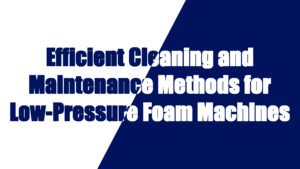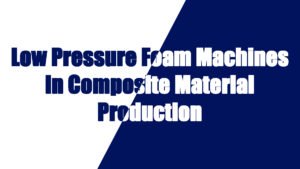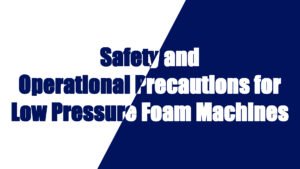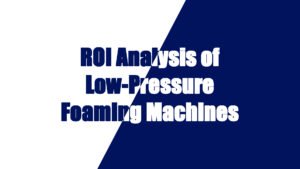The production of polyurethane foam is a complex chemical process that requires precise control over raw materials, equipment, and environmental conditions. Although the process is highly efficient and versatile, manufacturers often encounter challenges that can affect foam quality, production efficiency, and consistency. Below is a detailed analysis of common problems in polyurethane foam production and their solutions.
1. Inconsistent Foam Density
Problem:Inconsistent foam density can lead to poor structural integrity and reduced product performance.
Causes:
- Uneven mixing of polyol and isocyanate components.
- Unstable mixing head pressure.
- Incorrect calibration of the foam production machine.
Solutions:
- Regularly calibrate dosing pumps to ensure accurate raw material ratios.
- Maintain the mixing head pressure within optimal levels and clean it regularly to prevent blockages.
- Use advanced equipment with real-time monitoring and automatic adjustment to stabilize the mixing process.
2. Foam Shrinkage
Problem:Shrinkage occurs when the foam reduces in size after curing, leading to dimensional inaccuracies and weaker products.
Causes:
- Insufficient or improper use of blowing agents.
- High ambient humidity during production.
- Overheating during the curing process.
Solutions:
- Optimize the amount of blowing agent used to achieve the desired foam expansion.
- Use dehumidifiers or air dryers to reduce humidity in the production environment.
- Control curing temperatures carefully, using temperature-controlled systems to avoid overheating.
3. Foam Yellowing
Problem:Foam products may yellow over time, affecting their aesthetic appearance.
Causes:
- Exposure to UV radiation.
- Oxidation reactions within the foam.
- Low-quality raw materials with impurities.
Solutions:
- Add UV stabilizers or antioxidants to the foam formulation.
- Use high-quality raw materials from reliable suppliers.
- Store foam products in dark, climate-controlled environments to minimize UV exposure.
4. Uneven Surface or Poor Finish
Problem:Foam surfaces may exhibit defects such as bubbles, cracks, or uneven textures, which affect product appearance and usability.
Causes:
- Air trapped during the pouring or mixing process.
- Contamination in raw materials or mixing heads.
- Improper mold preparation or uneven application of release agents.
Solutions:
- Degas raw materials and use vacuum-assisted pouring systems to reduce trapped air.
- Regularly clean mixing equipment to prevent contamination.
- Apply mold release agents evenly and inspect molds for defects before production.
5. Foam Over-expansion
Problem:Over-expansion of the foam leads to dimensional inaccuracies, material waste, and difficulty in achieving the desired product shape.
Causes:
- Excessive blowing agents or high ambient temperature during production.
- Incorrect material quantity estimates.
Solutions:
- Adjust the foam formulation to use the correct amount of blowing agent to achieve target foam density.
- Maintain consistent production temperatures to avoid excessive expansion.
- Conduct small-scale tests before full-scale production to verify material quantities.
6. Poor Adhesion to Substrates
Problem:Foam does not adhere well to substrates, which is critical in applications like insulation panels or composite products.
Causes:
- Incompatible foam formulation with substrate material.
- Inadequate surface preparation or contamination.
Solutions:
- Modify the foam formulation to enhance adhesive properties, or use primers.
- Ensure substrates are clean, dry, and free from oils or debris.
- Preheat substrates to improve adhesion performance.
7. Slow Curing Times
Problem:Extended curing times reduce production efficiency and delay product delivery schedules.
Causes:
- Incorrect catalyst ratio in the formulation.
- Low ambient temperature during curing.
Solutions:
- Adjust the catalyst ratio to accelerate the reaction without compromising foam quality.
- Maintain an optimal production environment with controlled temperature and humidity levels.
- Incorporate fast-curing additives into the formulation to reduce curing times.
8. Odor Issues
Problem:Strong odors in finished foam products can cause customer dissatisfaction and indicate incomplete chemical reactions.
Causes:
- Low-quality or impure raw materials.
- Incomplete reaction of polyol and isocyanate components.
Solutions:
- Use high-purity raw materials from reputable suppliers.
- Ensure proper mixing and curing to allow complete chemical reactions.
- Add odor-neutralizing additives to the formulation.
9. Environmental Compliance Issues
Problem:Failure to meet environmental regulations can lead to fines and damage to a company’s reputation.
Causes:
- Use of restricted blowing agents or raw materials.
- High levels of VOC emissions during production.
Solutions:
- Switch to eco-friendly blowing agents, such as water-based or hydrofluoroolefins (HFOs).
- Install VOC capture systems or use low-emission formulations.
- Stay updated with local and international environmental regulations.
10. High Production Costs
Problem:High production costs can reduce profit margins and make a company less competitive.
Causes:
- Inefficient raw material usage or waste.
- Frequent equipment downtime or maintenance issues.
Solutions:
- Optimize raw material formulations to reduce waste without compromising quality.
- Invest in modern, energy-efficient foam production equipment.
- Implement preventive maintenance schedules to minimize equipment downtime.
11. Inconsistent Density Distribution
Problem:Uneven density distribution often occurs during large foam product production, affecting mechanical properties and thermal insulation.
Causes
- Inconsistent raw material flow: Inadequate control over the flow rate of raw materials during mixing can lead to uneven density.
- Poor diffusion of blowing agents: Blowing agents might not be evenly distributed, causing variations in the foam structure.
- Inappropriate mold design: A poor mold structure can lead to uneven material distribution.
Solution
- Use high-precision mixing equipment: To ensure uniform material flow and mixing.
- Optimize mold design: Use simulation software to design molds for even material distribution.
- Adjust process parameters: Extend mixing times to ensure blowing agents are evenly distributed.
12. Cracking or Shrinkage of Foam
Problem:Cracking or shrinkage often occurs during the curing process, which can compromise product appearance and mechanical strength.
Causes
- Too rapid curing: Fast curing can cause internal stresses that lead to cracking.
- Imbalanced catalyst proportions: Uneven reaction heat release due to incorrect catalyst amounts.
- Environmental factors: Fluctuating temperature and humidity during curing can cause defects.
Solution
- Optimize catalyst usage: Adjust the amount of catalyst to control the release of heat during curing.
- Control curing temperature: Maintain a stable curing environment (typically 20°C-25°C) to prevent cracking due to temperature fluctuations.
- Use low-shrinkage materials: Incorporate polymer-modified materials that reduce cracking risks.
13. Bubbles or Holes in Foam
Problem:Bubbles or holes may appear in the foam, especially during or after the curing process, affecting the structural integrity and appearance.
Causes
- Insufficient degassing of raw materials: Air trapped in the raw materials may result in bubbles.
- Poor mold surface treatment: Uneven release agent application may lead to localized defects in the foam.
Incomplete reaction: Insufficient reaction time can result in improper gas release.
Solution
- Vacuum degassing of raw materials: Use vacuum equipment to remove any trapped air from the raw materials.
- Improve mold release: Ensure the mold release agents are applied evenly and appropriately.
- Optimize curing time: Ensure sufficient reaction time and adjust temperature to promote proper curing and foam formation.
14. Odor or Environmental Problem:
Problem:Polyurethane foams may emit odors or release volatile organic compounds (VOCs) during production, which can affect user experience and violate environmental regulations.
Causes
- High VOC content in foaming agents or catalysts: These compounds can produce unpleasant odors or harmful emissions.
- Low-quality raw materials: Impure or substandard materials can produce additional by-products during the reaction.
Solution
- Use low-VOC or VOC-free foaming agents: Choose environmentally friendly materials with low global warming potential (such as HFOs).
- Install high-efficiency exhaust systems: To capture and filter harmful gases and odors.
- Optimize formulation: Use odor-neutralizing agents and high-quality raw materials to improve the product’s smell.
15. Slow Curing Time Leading to Low Production Efficiency
Problem:Long curing times reduce production efficiency, increasing unit costs.
Causes
- Low ambient temperature: Cold environments slow down chemical reactions.
- Insufficient catalyst content: Inadequate catalysts lead to slow reaction rates.
- Formulation not suited for fast curing: Some formulations are designed to cure slowly, which is inefficient in high-demand production environments.
Solution
- Increase the catalyst content: Introduce faster-reacting catalysts without compromising the final product’s performance.
- Control the curing environment: Maintain consistent temperature and humidity (typically 20°C-25°C) to speed up curing.
- Apply fast-curing resins: Use specialized fast-curing formulations when quick production is needed.
16. Surface Defects in Foam
Problem:Surface defects like roughness, irregularities, or dents can appear on the foam, affecting both the aesthetics and functional properties.
Causes
- Uneven pouring or injection: If the foam material is not poured or injected evenly, it may cause surface irregularities.
- Temperature fluctuations: Inconsistent mold temperature can cause surface imperfections.
- Impurities in raw materials: Contaminants in the raw materials can cause defects during the curing process.
Solution
- Adjust pouring/injection speed: Ensure that foam is poured or injected steadily and uniformly into the mold.
- Maintain consistent mold temperature: Control the mold’s temperature to avoid surface defects caused by overheating or cooling.
- Filter raw materials: Use high-quality, contaminant-free materials and ensure proper filtration.
17. Batch-to-Batch Variability in Foam Properties
Problem:Despite using the same formulation and processes, foam properties (such as density, hardness, elasticity) may vary between batches.
Causes
- Raw material batch-to-batch variability: Even when materials meet specifications, different batches can have slight variations affecting foam performance.
- Equipment wear and tear: Aging or malfunctioning equipment can cause fluctuations in processing conditions.
- Operator variability: Differences in the experience and skill level of operators can lead to inconsistencies.
Solution
- Regular testing and quality control: Test raw materials for consistency, and perform in-line quality control to catch Problem:s before they affect the final product.
- Routine equipment maintenance: Ensure that all equipment is properly maintained and calibrated.
- Standardize processes: Develop clear operational procedures and train employees to follow them strictly.
18. Foam Blockage During Production
Problem:Foam can become blocked in the production process, causing delays and reduced throughput.
Causes
- Overuse of catalysts: Using too much catalyst can cause rapid foam expansion, which may lead to blockage.
- Uneven distribution of blowing agents: If blowing agents are not properly distributed, foam may expand unevenly and block production lines.
- Mold design Problem:s: Poorly designed molds with narrow flow paths can restrict foam movement.
Solution
- Optimize catalyst use: Adjust catalyst quantities to control the speed of foam expansion and prevent clogging.
- Improve mixing and ingredient distribution: Ensure uniform mixing of raw materials and blowing agents to prevent blockages.
- Refine mold design: Ensure the mold has enough space and optimized pathways for foam flow.
19. Incomplete Foam Expansion
Problem:Incomplete expansion of the foam can lead to uneven structures, insufficient thermal insulation, and other performance issues.
Causes
- Insufficient reaction time: If the reaction does not complete, foam may not expand fully.
- Ineffective blowing agents: Poor quality or insufficient blowing agents may not adequately expand the foam.
- Environmental interference: Temperature and humidity can interfere with proper expansion.
Solution
- Extend the reaction time: Ensure sufficient time for the foam to expand fully before curing.
- Use effective blowing agents: Select high-quality blowing agents that perform well under various environmental conditions.
- Control environmental conditions: Maintain optimal temperatures and humidity levels during the expansion phase.
The production of polyurethane foam involves several challenges, from raw material handling to final product curing. Addressing these common issues through technology, process optimization, and quality control can significantly improve the production process. By implementing solutions like equipment upgrades, environmental control, and formulation adjustments, manufacturers can ensure better product consistency, reduced defects, and improved production efficiency. Additionally, adopting green chemistry practices and improving waste management will help keep the production process both cost-effective and environmentally friendly.




































